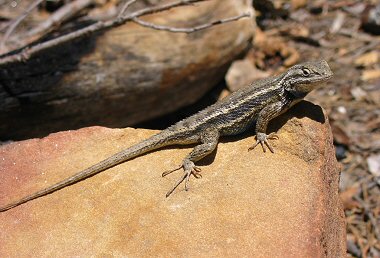|
REPTILES AND AMPHIBIANS Western Fence Lizard
|
|
|
|
|
The Western Fence Lizard ( Sceloporus occidentalis ) is the most common lizard found in California . The lizard is most commonly referred to as the “Blue-belly” or “swift” lizard. The western fence lizard can be found around indigenous plants like coastal sage shrub and chaparral. The lizard can adapt easily to the local San Luis Obispo surroundings because it uses camouflage to blend in with the rocks and plants. On campus when walking through the arboretum in the Mediterrian climate section I saw a blue-bellied lizard. I also saw another when I was at the EHS Unit. The western fence lizard can range from 10-15 cm long with a brown or black body coloring. Most adult males have lateral blue iridescent patches along their flanks. Male western fence lizards usually have a dominant blue coloration. The blue color on the female and juvenile lizards may not be as noticeable. The western fence lizard mainly feeds on spiders and insects. The easiest way to spot them is when they are sunning themselves on rocks or near trails in the canyon. This makes the lizard very vulnerable to predation by birds, such as hawks and snakes, like the kingsnake. The lizard is usually able to escape death through their fast reflexes and constant vigilance. One interesting fact about Western fence lizards is they have been known to diminish the danger of Lyme disease, associated from ticks. When the ticks feed on the blood of the lizards, the bacterium that causes the disease disappears. |

